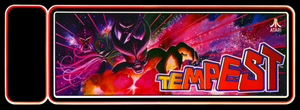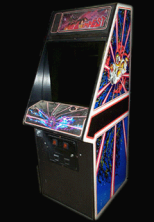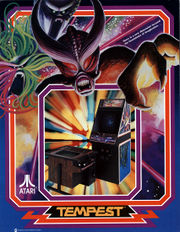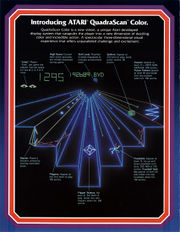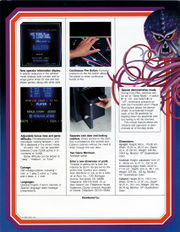Lost In Translation/Tempest
| Tempest | |
|---|---|
| Manufacturer | Atari |
| Released | 1980 |
| Control Method |
Dial 2 Button(s) |
| Main CPU | M6502 (@ 1.512 MHz) |
| Sound CPU | Mono (2x) POKEY (@ 1.512 MHz) |
| Video Details |
Vector (Vertical) 0 x 0 pixels 60.00 Hz 256 Palette colours |
| Screens | 1 |
| ROM Info | 20 ROMs 26,400 bytes (25.78 KiB) |
| MAME ID | tempest · tempest1 · tempest2 · tempest3 · temptube |
About The Game
Tempest is a 3-D, chase-view, arcade video game shoot-em-up.
Tempest introduces additional new features :
- Skill-Step with 99 skill levels of play
- Operator-information display
- Demonstration mode with freeze
Skill-Step allows a player to start a game at the same level as was previously achieved (he must start the next game within 30 seconds), without having to start over at the beginning levels. Therefore, skilful players continue to be challenged while less experienced players try to master higher levels. The 99 skill levels of play include 16 different play-fields and 6 different targets.
In the play mode, a player-controlled, yellow claw-like shooter moves around on a 3-D tube-like play-field. The shooter rotates on the end of the tube that is nearest to the player. Enemies land on the end of the tube that is farthest away from the player to climb toward and attack the shooter. The shooter fires down the tube at the approaching enemies. When a player kills all the enemies on a tube, he blasts through the tube, flies through space, lands on a new tube-like play-field, and fights the enemies on that play-field. A player scores points by shooting enemies and by blasting through the tube to a new level. The player loses a life when killed by the enemy. The game is over when all the player's lives are gone.
All action occurs on one of sixteen suspended tube-like play-fields. The 3-D tube surfaces are viewed from the top, so the view of the first play-field (a circle) is like looking into a well. Each play-field is made of 16 rails which connect the nearest to the farthest rim. The play-field colour changes every 16 levels : level 1 is blue, level 17-red, level 33-yellow, level 49-cyan, 65-invisible and 81-green.
In addition, other events cause play-field colour variation. The shooter causes the 2 rails on which it sits to change colour. Superzap causes the play-field to flash as enemies are zapped. Play-field rails flash rainbow colours when a player earns a bonus life. Pulsar enemies cause sections of the nearest rim to disappear, and during the pulse phase, adjacent rails to flash.
The player's shooter is controlled by rotating the control-panel knob. The shooter moves around on the nearest rim of the tube-like play-field. The ends of the shooter always touch two adjacent rails. The rails on which the shooter sit change colour (yellow in levels 1-16) which gives a flash-light effect and helps the player see the enemies in his lane.
A player shoots by pressing the fire button : tap it for 1 or 2 shots or press it for all 8 shots. A shot is extinguished when it hits an enemy, after it passes the far rim or after it ploughs a certain distance into an enemy spike. A shot is renewed after it is extinguished so there may be a maximum of eight shots on the screen at one time.
A player may use two superzaps per level. A first superzap kills all enemies on the play-field at the time of firing. A second superzap randomly kills one enemy on the play-field. The superzap does not affect enemy shots, spikes or enemies not yet landed on the play-field. Superzap is recharged when the player blasts to a new level.
Tempest Level Shapes
- Circle
- Square
- Plus
- Bow-tie
- Stylized Cross
- Triangle
- Clover
- V
- Steps
- U
- Flat (bowling alley)
- Heart
- Star
- W
- Fan
- Infinity (figure 8 on its side)
Tempest Level Color Schemes
| Level | Tunnel | Player Ship | Super Zapper | Flippers | Tankers | Spikers/Spikes | Pulsars |
|---|---|---|---|---|---|---|---|
| 1-16 | Blue | Yellow | Yellow | Red | Purple | Green | N/A |
| 17-32 | Red | Green | Cyan | Purple | Blue | Cyan | Yellow |
| 33-48 | Yellow | Blue | Blue | Green | Cyan | Red | Blue |
| 49-64 | Cyan | Blue | Red | Green | Purple | Red | Yellow |
| 65-80 | Black (invisible) | Yellow | White | Red | Purple | Green | Cyan |
| 81-96 | Green | Red | Purple | Yellow | Purple | Blue | Yellow |
Levels 97 and up - Keeps colour scheme from Levels 81-96, with random shapes from Level 99 onward
Additional Technical Information
Players : 2
Control : dial
Buttons : 2
= > (1) Fire, (2) Super Zapper
Trivia
Released in October 1981.
Tempest was an awesome arcade game that transported the player into abstract realms of space. Soaring into its second decade of life, Tempest is still the favourite of devotees who seek to become one with this adventure through hyperspace. Approximately 29,900 units were produced. Tempest sold approximately 20,000 units to distributors before it was even released.
Tempest was the first game to use 'Color-Quadrascan' and 'Skill-Step', both features unique to Atari vector games. Tempest was originally a 3-D "Space Invaders" clone called 'Vortex', but was changed when the other engineers didn't come back to play the game. This was kind of a test for an Atari game; if the engineers kept coming back to play a new game, it was considered a hit.
The first prototype of the game had the shape wire-frame spinning and the gunner remaining stationary, but that caused motion sickness after a period of time so it was changed around.
The Creation Of Tempest
Dave Theurer, who designed the game and wrote the software, said his original intention was to make a first-person perspective of the "Space Invaders" game, but he ended up doing something completely new and different. Rich Adam : "Dave implemented a first-person "Space Invaders". Everybody played it but they didn't keep coming back. You could tell when you had something cool, the engineers kept coming back. This was good and bad because there were times when you wanted to work on your game and everybody would want to be playing it. But when he was doing the first-person "Space Invaders", Dave didn't run into this problem of everyone wanting to play the game... and he said to himself : 'Well, maybe this isn't working. What can I do?' Then I came in one day and all of a sudden he had this round tube with these things coming up it. I said, 'What the heck is that Dave?' He said, 'I don't know. Aliens from the center of the Earth? I don't know.' I think he said something about having had a dream about it. I said, 'How does it work?' He said, 'I don't know. They're coming up around the edge of this thing and you're trying to blow them away.' He just sort of started out with this concept and took it from there. I can see why he would say that Tempest was certainly his proudest achievement. He worked extremely hard on that. It's pure creation from his own brain.".
Remembrances From The Video Game Masters
Although known for his hard work and for his ability to focus on and conquer exceedingly tough software problems, Dave Theurer looks back upon his days at Atari as having been fun and rewarding. Dave Theurer : "It was just so exciting working on these new games. All my life I loved explosions. When I went to college I was a chemistry major because I wanted to do something where I could make explosions. When I was a kid I had a chemistry set and I'd blow stuff up all the time. Eventually, you learn that you can't really do that in real life, so the next best thing is to do it on the screen, so here I was blowing stuff up on the screen. Simulating real life is fun too. It's almost like you can create your own universe. Well, you are creating your own universe. That's rewarding, to see something come alive.".
Playing games, both video and pinball, was a constant part of life for the engineers at Atari. Dan Pliskin : "In the morning, I used to go in and I'd make up a pot of Italian roast or French roast coffee and pour myself a big mug. Then I'd go and sit it on a pinball machine and drink coffee and play pinball until scores got up to, like, a couple hundred thousand. That would be my indication that I was sharp enough to go and design something.".
Popular From The Start
Tempest was a game that immediately captivated people from the very start. Lyle Rains : "Like a number of these games that were very addictive, the Tempest controls were good enough to where once you learned how to manipulate them you could almost become one with the machine. That is, a good Tempest player gets to spin that knob and do the firing in the right time and get into sync with the machine or get into a rhythm. I don't know exactly what to call it, but you were so close to the action that part of you entered the experience. You forgot about what was going on around you and you were just there. And you could get very good at it. I think what people like is the ability to accomplish amazing things".
The Great 25-Cent Escape
Not only did players often find a sense of welcome escape in the video games they played, but this was very much the intention of some of the great game designers. Dave Theurer : "I want to design it for a guy who's totally frazzled by his job and needs a way to temporarily escape. There's a certain class of games... where you just get into a trance when you're playing them. As long as you're in this trance you'll do fine.".
Tempest was available in 3 different dedicated cabinets. An upright, a cabaret, and a cocktail. The upright machine came in a nice arrow shaped cabinet that featured one long straight angled line from the top of the cabinet to the bottom of the control panel. This design makes it very easy to spot converted Tempest cabinets. The Tempest marquee had a whole bunch of glowing purple lines along with an evil looking crawly thing that looked like it was coming right at you. The side art had kind of a spacey look to it, with a bunch of red lines radiating out from a central point that had monsters crawling out of it! The control panel had more spacey lines and holes graphics, along with an optical spinner and a pair of fire buttons. The cocktail version was a black square table with a wood grain top. It had red lines and instructions underneath the glass, with player control panels on either side. For some reason the monitors on these were installed butted up against one side, instead of centred. Both the cocktail and the upright used a colour X-Y monitor.
The default high score screen of "Cyberball 2072" features names of many Atari arcade games, including TEMPEST.
A Tempest unit appears in the 1982 movie 'Fast Times at Ridgemont High', in the 1983 movie 'Twilight Zone - The Movie', in the 1983 movie 'Joysticks', in the 1984 movie 'Night of the Comet', in the 1986 movie 'Running Scared', in the 1986 movie 'Maximum Overdrive' (A cocktail cabinet) and in the 1987 movie 'Death Wish 4 - The Crackdown'.
A Tempest unit appears in the music video 'Subdivisions' by RUSH.
3 Tempest machines (one was 'serial #1' !) were shown at the 2003 classic arcade games show 'California Extreme' in San Jose, California.
In 1982, Atari released a set of 12 collector pins including : "Missile Command", "Battle Zone", "Tempest", "Asteroids Deluxe", "Space Duel", "Centipede", "Gravitar", "Dig Dug", "Kangaroo", "Xevious", "Millipede" and "Food Fight".
Updates
- Revision 1
- First public release.
- Revision 2
- Fixes the score cheat in test mode.
- Changes spinner letters to a line.
- Revision 3
- Fixes screen collapse between 1 and 2 players in the 2 player mode.
Scoring
| Target | Points |
|---|---|
| Spike | 1-3 |
| Spiker | 50 |
| Tanker | 100 |
| Flipper | 150 |
| Pulsar | 200 |
| Fuseball | 250, 500, or 750 |
In addition to the above points, you also get bonus points for starting at higher levels then level one. Listed are the bonus points through the first 49 levels. There is no real pattern except that the bonus gets higher the more levels you skip at your starting point.
| Level | Points |
|---|---|
| 3 | 6,000 |
| 5 | 16,000 |
| 7 | 32,000 |
| 9 | 54,000 |
| 11 | 74,000 |
| 13 | 94,000 |
| 15 | 114,000 |
| 17 | 134,000 |
| 20 | 152,000 |
| 22 | 170,000 |
| 24 | 188,000 |
| 26 | 208,000 |
| 28 | 226,000 |
| 31 | 248,000 |
| 33 | 266,000 |
| 36 | 300,000 |
| 40 | 340,000 |
| 44 | 382,000 |
| 47 | 415,000 |
| 49 | 439,000 |
At the beginning of the game, you can skip to level 7. Whenever you complete a game, you have either ten seconds or until you press a key to continue a game. You can start a game at the bonus level you were closest to from your last game. For example, if your game ended on level 21, then you can go to all
the bonus levels at level 20 and below. If your game ended at level 42, then you can go to all bonus levels at level 40 and below.
Tips and tricks
Hints
- Players should work their way up through the levels to become familiar with game play. Drop down a level if play is too difficult.
- Experienced players should start at highest level possible for maximum points.
- On a new play-field shoot at enemy dots at far rim.
- Shoot the flipper as soon as it starts to flip.
- Use long spikes to reclaim shots and kill enemies approaching you from adjacent lanes.
- Avoid shooting fuseball-tankers near the top since emerging fuseballs usually zip up to the top and kill you.
- Use Superzap right before last enemy reaches the top for a few extra points.
898,000 Points Bonus
- You must have the Revision 1 ROMs in your machine.
- You must have your machine set to coins and not on free-play.
- Start a game and play until you successfully clear the red V stage. Die.
- Start a new game on the red V level and complete the stage to get a bonus taking your score to more than 160,000.
- As soon as you get the bonus from clearing the red V level get the last two digits of your score to 46 (by shooting spikes). Die.
- Wait! Wait for one cycle of the machine's attract mode - high score initials, TEMPEST attract, game demonstration, high score table.
- Start a new game, spin the spinner to the right all the way up to level 1 of the green stages.
- Complete the stage for a bonus of 898,000.
Intentional Cheats
These are cheats (They weren't cheats at all. They were intentionally programmed in as a security measure). They were removed in ROM 217 and 222 software revision 2. First, you must complete level 8 and get a score with the format XXYYZZ : XX must be greater than 16, YY between 29 and 60, ZZ is a code listed below: -
| Code | Action |
|---|---|
| 00 | freeze screen |
| 01 | access bookkeeping totals |
| 05 | allows playing during attract mode |
| 06 | 40 free credits |
| 11 | 40 free credits |
| 12 | 40 free credits |
| 14 | credit sound without actual credit |
| 15 | credit sound without actual credit |
| 16 | 40 free credits |
| 17 | 40 free credits |
| 18 | 40 free credits |
| 41 | switch last 2 digits of score |
| 42 | increase score quickly |
| 46 | demonstration mode - start at any level, up to level 81 |
| 50 | player moves by itself |
| 51 | player moves by itself |
| 60 | objects drift down |
| 66 | objects drift right |
| 67 | objects jump |
| 68 | objects drift up |
| 70 | objects drift up |
After code '05' (play during attract mode) is activated, the following cheats become available...
Set the last two digits to 46 : Random-colored level with wrong enemies.
Set the last two digits to 48 : 255 extra lives.
Tips For New Players
Here are some quick tips for anyone new to Tempest (note : Level colours mentioned below refer to the level's tunnel colour) :
- Flippers first appear in Level 1 (blue circle), but don't start flipping until Level 2 (blue square). Flippers flip at a constant rate, so play the angles. You can kill flippers on the outer edge by shooting when they are in the spaces next to you (as they flip). The wider the angle, the more time you have to shoot. You can also move under them as they flip. Good practice is to play level 1 as long as possible without firing. On the open shapes, you will want to hang out on one end of the other (to avoid attacks from both directions). On closed shapes, pick a spot with good angles and good visibility. Often flipping back and forth between two spaces (playing the angles depending on which direction the flippers are attacking from) is all you have to do.
- Tankers first appear in Level 3 (blue plus). Regular tankers contain two flippers. Feel free to shoot them and their cargo with impunity. Fuseball tankers are VERY dangerous. Shoot them and get out of the way. Pulsar tankers are also very dangerous. Shoot them and stay where you are (the pulsars will appear to either side). You can differentiate between the types of tankers by looking closely at their centres. Fuseball and pulsar tankers have tiny pictures of their cargos in their centres. The ability to instantly differentiate between tanker types is probably the most important ability separating good Tempest players from great Tempest players.
- Spikers first appear in Level 4 (blue bow-tie). Spikers are generally harmless (although they do shoot at you), and the spikes they lay down are very handy some times. You can hold the fire button down for continuous fire, but you only get a maximum of eight shots at a time. This is enough to fill half the tube, but not enough for a true continuous stream of shots. If you have lots of flippers coming after you, find a long spike to sit on top of. You can then hold down the fire button for a machine gun effect. As the spike gets eaten away, look for another one to switch to. Be careful of pulsars and fuseballs when you do this however. When you get to level 65 (black/invisible circle) try riding a full spike all the way down at the end of the round. Your descent rate and rate of fire are perfectly matched so that you can actually blast it away without being impaled all the way to the bottom.
- Fuseballs first appear in Level 11 (blue flat/bowling alley). Fuseballs ride the lines. The safest place to be is in the space NEXT to one. It looks like it will kill you, but the hit logic only tests the centre of the fuseball. Fuseballs will only cross one space at a time before dropping back down (until the end of the round when they start chasing you). If you get stuck with one coming after you at the end of a round (usually on one of the open shapes), try the 'Hail Mary' move of spinning very quickly. You can actually jump over one or more spaces (and a fuseball!) if you spin fast enough. Watch out for fuseball tankers at higher levels that split into two fuseballs that will immediately try and jump on you.
- Pulsars first appear in Level 17 (red circle). Pulsars are only dangerous when they are pulsing. Listen to the low, periodic buzz sound. As you get used to it, you will find yourself adapting to this built-in rhythm. You can shoot them when they aren't pulsing or spin out of the way. Watch out for pulsar tankers at higher levels that split into 2 pulsars on either side of the tanker lane.
- Dip Switch #2 (2nd from the back of the game) on the upper bank (at N13) controls demo mode. Demo mode lets you start (and practice) anywhere you like. It does not record scores, however. In normal play, the game will let you start close to where you left off. If you want to 'cheat', put the game into demo mode, spin up to where you want to start, start the game and hit the player one start button causing you to zoom down the tube and gain the bonus. Then die and flip the dip switch back to normal mode. Now you can start a real game at the same level and record your score at the end. If you do this often, wiring a front-mounted bypass to that dip switch will come in very handy. There is also a freeze game dip switch that is also handy in case the phone rings while you are playing.
- Level 81 (green circle) is the highest starting level. Most expert Tempest players agree that green is actually easier than the black/invisible levels that precede it. It is a bit faster, but it restores one of the most valuable visual clues in the game - the tell tale break in the outer edge caused by a pulsar (which is missing in the black/invisible levels). After level 96 (green figure eight/infinity), you are back to the green circle (97) and green square (98). Level 99 is the highest recorded by the game and consists of a never ending supply of random green shapes. Every time you finish the round or loose a life, you will end up with a different shape. To achieve a world record score, you will spend MOST of your time playing level 99 over and over again. If you can keep your rate of loss to roughly one life per two rounds (at 20K bonus), you can theoretically play forever. Tempest isn't a very good marathon game, however, as it only lets you build up 5 lives max. at any one time. A 30-second bladder break while playing level 99 will pretty much wipe you out.
- The highest score recordable by the game is 999,999 (a horrible error on the part of the designers). Starting at 81, you get there pretty fast (mid way through the greens). With a bit of practice, you can end the game at exactly 999,999. Do that 3 times and no one will ever be able to beat your score on a single machine (w/o clearing the high score table).
Series
- Tempest (1981)
- Tempest 2000 (1994, Atari Jaguar)
- Tempest X (1996, Sony PlayStation)
- Tempest 3000 (2000, Nuon)
Staff
- Designed & Programmed By
- Dave Theurer (DFT)
- Project Leader
- Morgan Hoff (MPH)
- Hardware Guy
- (SDL)
- Technician
- (MJP)
- From Hiscore Table
- Eric Durfey (EJD)
- Dave Shepperd (DES)
- (RRR)
- (BEH)
Cabinet and Artwork
Ports
- Consoles
- Atari 2600 (1983) (Prototype only)
- Atari 5200 (1983) (Prototype only)
- Atari 2600 (1984)
- Atari Jaguar (1994, "Tempest 2000")
- Sony PlayStation (1996, "Arcade's Greatest Hits - The Atari Collection 1")
- Nintendo Super Famicom (1997, "Arcade's Greatest Hits - The Atari Collection 1")
- Sega Saturn (1997, "Arcade's Greatest Hits - The Atari Collection 1")
- Sony PlayStation (2001, "Atari Anniversary Edition Redux")
- Sega Dreamcast (2001, "Atari Anniversary Edition")
- Nintendo Game Boy Advance (2002, "Atari Anniversary Advance")
- Sony PlayStation 2 (2004, "Atari Anthology")
- Microsoft XBOX (2004, "Atari Anthology")
- Nintendo DS (2005, "Retro Atari Classics")
- Computers
- Apple II (1983, "Tubeway")
- Acorn Electron (1985)
- Amstrad CPC (1986)
- Atari ST (1989)
- PC [MS Windows, 3.5] (1993, "Microsoft Arcade")
- PC [MS Windows, CD-Rom] (1999, "Atari Arcade hits 1")
- PC [MS Windows, CD-Rom] (2001, "Atari Anniversary Edition")
- PC [MS Windows, CD-Rom] (2003, "Atari - 80 Classic Games in One!")
- Commodore C64 ("Genesis")
- Sinclair ZX Spectrum
- Commodore Amiga
- Others
- Nokia N-Gage (2006, "Atari Masterpieces Volume 2")
Soundtrack Releases
| Album Name | Catalogue No. | Released | Publisher | Comments |
|---|---|---|---|---|
| Arcade Ambiance 1981 | N/A[1] | 2002-01-01 | Andy Hofle | Digital download only. |
| Softmax 10th Anniversary Original Sound Track | N/A[2] | 2004-12-01 | Softmax | CD version. |
External Links
- Sinclair ZX Spectrum version of Tempest at the World of Spectrum


